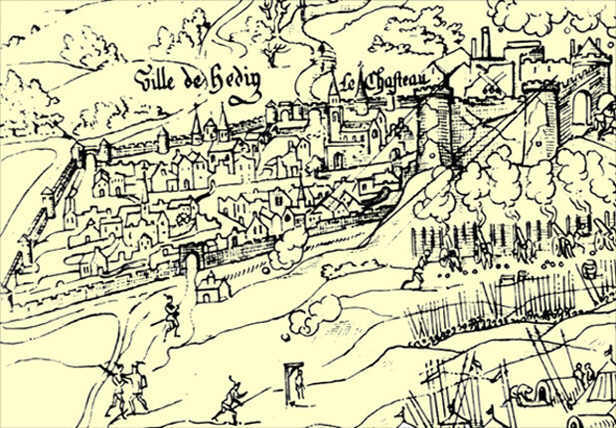
|
|
|
|
|
| battlefields | |
| traces of conflict to see and visit | |
|
|
|
|
|
|
|
|
|
| middle ages | |
| The North of France has often been a battlefield. In our time the many military cemeteries from both World Wars are a poignant reminder of that. For the forces of the Commonwealth alone our département (Pas-de-Calais) has 628 cemeteries containing more than 180.000 burials. But as early as six hundred years before these bloodiest of all wars battles were fought on the same soil by the French and English kings (Hundred Years' War) and subsequently control of the region was disputed between the Kingdom of France and the Dukes of Burgundy and their successors. Of these early conflicts only few traces are visible today. Many castles were built but nearly just as many have since been destroyed. | |
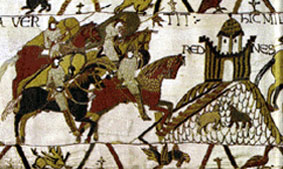
|
Early in the Middle Ages Oeuf itself had a motte féodale (a primitive castle) not far from the present church. All that can be seen on that spot now is a faint slope in the field (photos: fragment of the Bayeux Tapestry displaying a motte féodale and scale model based upon that depiction). Nearby Wignacourt (a hamlet belonging to Croisette, neighbouring village of Oeuf) had a castle, the outlines of which are still somewhat visible in the landscape. Only slightly more is currently left of the once enormous castle of Saint-Pol. Around its ruins an open air theatre and excercise track have now been layed out. |
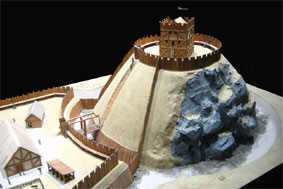
|
|
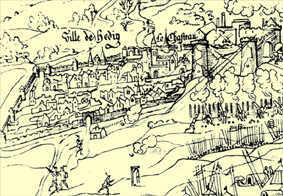
|
In Vieil-Hesdin, some kilometres West of Oeuf and once of an importance comparable to that of Arras, little is left to remind of its glorious past. Just like Oeuf, the town was all but erased by Charles V (the Holy Roman Emperor) halfway through the sixteenth century. Illustration: siege of (Vieil-) Hesdin, detail (see larger version at top of page). |
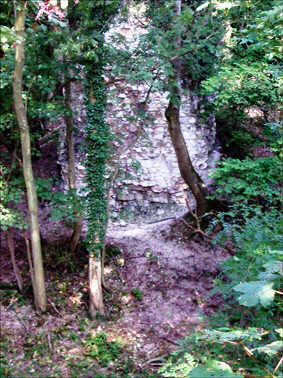
|
Here and there in Vieil-Hesdin remnants of its fortifications are still visible. Of its medieval castle -now on private land and not accessible- only some chunks are left (photo: remains of a tower). |
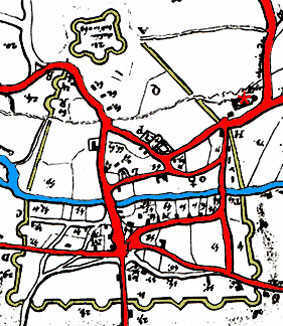
|
The old map on the left shows Vieil-Hesdin with its fortifications. On it, today's street plan (indicated in red) can easily be recognized (the asterisk indicates the location of the present village church). See also the website of the historical association of Vieil-Hesdin. |
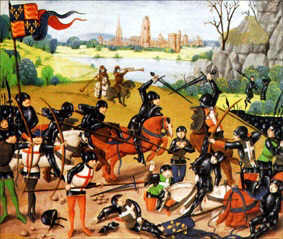
|
Those interested in the Middle Ages should certainly visit the museum of Azincourt (Agincourt). This museum is entirely dedicated to the famous battle (illustration) of 1415 in which the English -although far outnumbered- crushed the French. Marching towards Azincourt the English troops must have passed Oeuf at a distance of a few kilometres at most. On your way to Azincourt I would suggest a small detour to visit Fressin with its considerable remains of a castle from the late Middle Ages. |
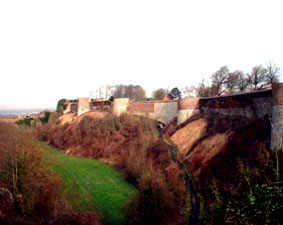
|
Seeing medieval buildings not in ruins requires travelling a little further, to Montreuil for example (an entirely walled-in town with citadel), Olhain (immaculately preserved medieval castle with bailey) or Bours (keep). |
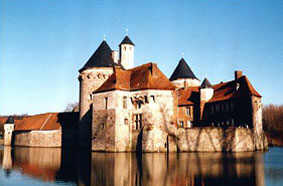
|
|
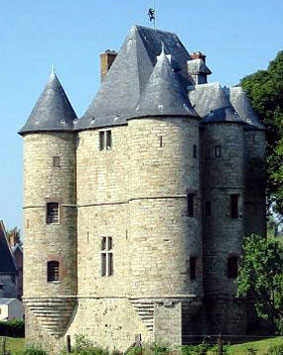
|
|
|
|
|
| first world war | |
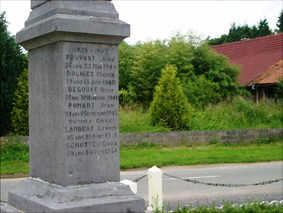
|
Of the later conflicts the Great War never fails to move one. Just like nearly every other French village Oeuf has a war memorial to commemorate the inhabitants who didn't return from the battlefields. The list on the monument counts twenty-one names, a nearly incomprehensible -but by no means exceptional- sacrifice for a village this size (now 253 inhabitants, then some more). Visual traces of this war are scarce in Oeuf and its vicinity as the village itself never was in the frontline. |
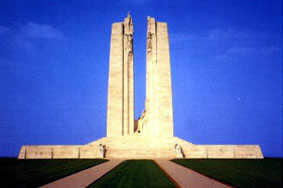
|
The imposing World War I Memorial at Vimy (near Arras, photo) is a forty minutes' drive from Oeuf. It commemorates the battle fought there by Canadian troops. The battlefield has been partly preserved, including some trenches. A tunnel dug by the Canadians underneath the (enemy) trenches can be visited (guided tour). |
|
|
|
| second world war | |
| In our region the Second World War has left far more visible traces than the First. In Oeuf German troops were present in large numbers as there were crews for anti aircraft artillery, for searchlight units and for the V1-launch ramp located near number 24 rue d'Agerue. In addition to all that there was a seemingly endless stream of German conscripts who were trained in Oeuf to fight (and quite likely perish) on the Eastern Front. Many of the German troops were billeted with French families. This was also the case in my house where I found several momento's of their presence: a smashed mantelpiece, a swastika carved in a window sill and a machine-gun bullet (unused) somewhere in the attic. | |
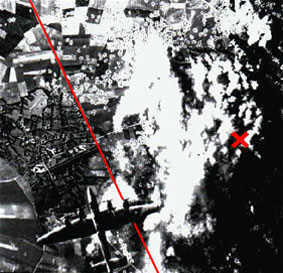
|
Just a few kilometres East of Oeuf, in the village of Siracourt an enormous bunker was being built by the Organisation Todt. This bunker was intended for the assembly and launch of V1's. After its discovery the -still unfinished- bunker was intensively bombed by allied forces. To that end the bombers dropped their cargo often from a high altitude right above Oeuf. Following their track the bombs would then normally hit Siracourt. The photo on the left shows an allied bomber shortly after an attack on Siracourt. If my interpretation is correct the bomber flies more or less parallel to the route départementale D939, indicated in red by me; the bunker itself, at the location marked with the red cross, is obscured by clouds of dust caused by the impact. |
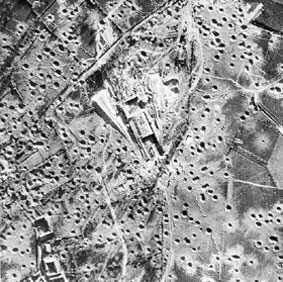
|
The second photo is an official reconnaisance photo and gives an impression of the scale of the bombings. In all 30.000 bombs were dropped on Siracourt. |
|
The actual fighting in Oeuf consisted mainly of attacks on the local V1-launch ramp in the summer of 1944. These attacks left many homes on the West side of Oeuf damaged or even destroyed. At least one allied bomber was shot down above Oeuf, it crashed next to the road to Beauvois. Two civilians were killed in Oeuf. Emile Schotter was killed while working on a field in the vicinity of the V1-launch ramp when the ignition of a crashed V1 exploded. The other victim, Etienne Lambert, fell on a farm that was hit by a bomb that went astray. Their names are on the war memorial. The church was severely damaged when an allied bomb hit it on the 31st of July, 1944. Following the war only the church tower could be restored, the nave was replaced by a modern one in the early sixties. |
|
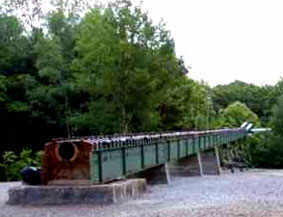
|
Not far from the town of St. Omer (a forty-five minutes' drive from Oeuf) is the blockhaus of Eperlecques, a gigantic bunker intended for the production of liquid oxygen and (according to the original plans anyway) the assembly and launch of V2's. Outside the bunker a V1-launch ramp -comparable to the one in Oeuf- has been reconstructed (photo). |
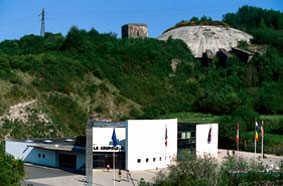
|
Also near St. Omer and just as gigantic is the dome of Helfaut (La Coupole, photo). This bunker was intended as a launch base for V2's but was never used for that purpose. It now houses an exhibition on North Western France under German occupation. It also has a section on space exploration which, after all, could build on the research for the V2. |
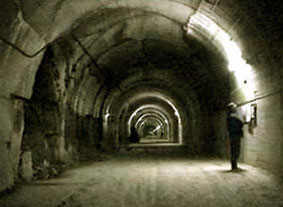
|
Finally there is the lesser known V3-base of Mimoyecques near Calais. From this base London was to be attacked with twenty-five underground superguns, their barrels 130 metres long. Technical setbacks and repeated allied attacks prevented this from happening. The remains of the base (photo) can be visited. |
|
|
|
| © 2005 - 2010 Rob Zeldenrust, Oeuf-en-Ternois, France. | |
